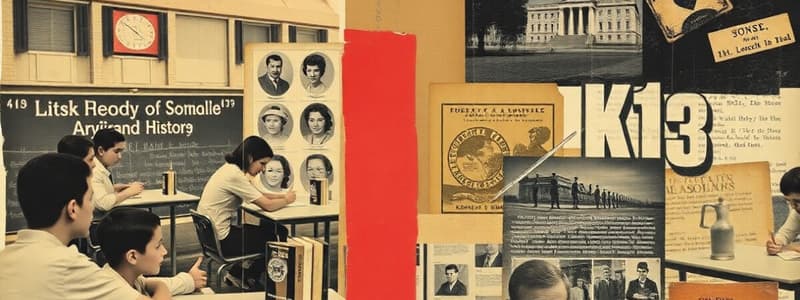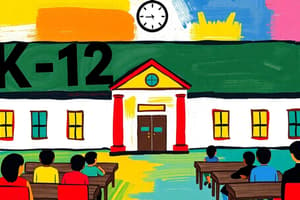Podcast
Questions and Answers
What was a common way to fund education in early American schools, even when they were subsidized?
What was a common way to fund education in early American schools, even when they were subsidized?
Rate bills
What type of schools were operated by women in their homes, providing daycare along with some basic instruction?
What type of schools were operated by women in their homes, providing daycare along with some basic instruction?
Dame schools
According to Schoolmaster's Confessions, were classrooms typically single-age or mixed-age in early 19th-century schools?
According to Schoolmaster's Confessions, were classrooms typically single-age or mixed-age in early 19th-century schools?
Mixed-age
Name one of the two common school reformers mentioned.
Name one of the two common school reformers mentioned.
What was the name given to the type of school advocated for by reformers in the 1840s?
What was the name given to the type of school advocated for by reformers in the 1840s?
What type of schools were established to standardize teacher training during the Common School Era?
What type of schools were established to standardize teacher training during the Common School Era?
What type of laws required parents to send their children to school?
What type of laws required parents to send their children to school?
What principles were applied to curriculum and teaching methods during the Consolidation Era, aiming for systematic instruction?
What principles were applied to curriculum and teaching methods during the Consolidation Era, aiming for systematic instruction?
What type of test was introduced to sort students into different educational tracks based on ability during the Consolidation Era?
What type of test was introduced to sort students into different educational tracks based on ability during the Consolidation Era?
What standardized test was introduced in 1926 to help prepare students for college?
What standardized test was introduced in 1926 to help prepare students for college?
Flashcards
Colonial/Early American Education
Colonial/Early American Education
Education was primarily the responsibility of individual colonies or states, leading to highly localized and varied practices.
Rate Bills
Rate Bills
Schools where families paid tuition, even when the school received town funding.
Charity Schools
Charity Schools
Basic reading, mathematics, and religious instruction for the poor, supported by churches.
Dame Schools
Dame Schools
Signup and view all the flashcards
Common School Era
Common School Era
Signup and view all the flashcards
Horace Mann
Horace Mann
Signup and view all the flashcards
Normal Schools
Normal Schools
Signup and view all the flashcards
Consolidation Era
Consolidation Era
Signup and view all the flashcards
Scientific Management
Scientific Management
Signup and view all the flashcards
IQ Tests
IQ Tests
Signup and view all the flashcards
Study Notes
Overview of American K-12 School History
- The evolution of American K-12 schools can be divided into three phases: colonial/early American schools, the common school era, and the consolidation era.
- The history is characterized by a shift from less standardized education to more standardized education.
Colonial and Early American Schools
- Education was primarily the responsibility of individual colonies or states.
- States often deferred educational decisions to districts and townships.
- Education during this time was highly localized and varied.
- Some New England townships used town money to establish one-room schoolhouses, subsidizing tuition for students.
- Rate bills were common, requiring families to pay tuition even at these subsidized schools.
- Academies provided more systematic instruction, but were generally accessible to wealthier families.
- Charity schools, supported by churches, offered basic reading, mathematics, and religious instruction, primarily for the poor.
- Dame schools, operated by women in their homes, provided daycare with some remedial instruction.
- Families sought education options that suited their needs and financial means.
- There was a lack of unification in education between the states.
- States and townships did their own thing
Insights from a Schoolmaster's Confessions (1839)
- The book provides insights into the realities of early 19th-century schools.
- Classrooms consisted of mixed-age students with varying levels of ability.
- Attendance was irregular, with students attending based on family needs and preferences.
- Teachers adapted instruction to the diverse needs of students, grouping them based on ability.
- Teachers faced the challenge of teaching students of mixed ability at the same time
The Common School Era (c. 1840)
- Reformers like Horace Mann (Massachusetts) and Henry Barnard (Connecticut) advocated for systematic public schools, then called common schools.
- The goal was to increase attendance at common schools through various reforms.
- Abolishing rate bills made common schools free for all students.
- Teacher training was standardized through normal schools to professionalize the teaching force.
- There were attempts to move schools away from the one-room schoolhouse model.
- Attempts were made to get more students in smaller classrooms
- Compulsory education laws were passed, starting with Massachusetts in 1852 and ending with Mississippi in 1917.
- State funding for education increased, making public schools more attractive than private schools.
- Public schools became more commonplace
Consolidation Era
- This era was characterized by larger, more systematized schools.
- Schools were divided into classrooms with age-based groupings.
- Scientific management principles were applied to curriculum and pedagogy, aiming for systematic and "scientific" teaching methods.
- Experts designed curriculum and pedagogical methods to standardize instruction.
- While promoting standardization, this approach reduced the teacher's autonomy.
- Desks got unbolted to the floor so that teachers could choose how the rooms would look
- High schools became more widely attended in the early 1900s, driven by compulsory education.
- IQ tests were introduced to sort students into different educational tracks based on ability.
- Middle schools were established to cater to the unique needs of adolescents.
- The SAT was introduced in 1926 to prepare students for college.
- The SAT being used for colleges had an effect on high school teachings
- This era balanced standardization with some differentiation in approach.
Studying That Suits You
Use AI to generate personalized quizzes and flashcards to suit your learning preferences.



